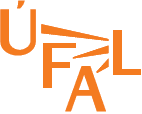Differences
This shows you the differences between two versions of the page.
| Both sides previous revision Previous revision Next revision | Previous revision | ||
|
cost-training-school-2017:synopsis_sc [2017/01/12 10:04] ufal |
cost-training-school-2017:synopsis_sc [2017/01/27 15:29] (current) ufal |
||
|---|---|---|---|
| Line 4: | Line 4: | ||
| The tutorial seeks to provide students with a basic understanding of data analysis applied to a particular linguistic data set and to a set of working hypotheses concerning the association between genre and discourse structure, using a few common statistical methods. | The tutorial seeks to provide students with a basic understanding of data analysis applied to a particular linguistic data set and to a set of working hypotheses concerning the association between genre and discourse structure, using a few common statistical methods. | ||
| - | The dataset contains annotations of discourse | + | The dataset contains annotations of discourse |
| 1. describe and summarize the data set, as well as prepare it for further statistical analysis (key words: "tidy data" and "data wrangling" | 1. describe and summarize the data set, as well as prepare it for further statistical analysis (key words: "tidy data" and "data wrangling" | ||
| Line 13: | Line 13: | ||
| This tutorial is meant to serve as a starter for individual studies of quantitative methods in linguistics aided by R. No effort is being made to explain the mathematical background of the statistical concepts and methods used. | This tutorial is meant to serve as a starter for individual studies of quantitative methods in linguistics aided by R. No effort is being made to explain the mathematical background of the statistical concepts and methods used. | ||
| + | === References: === | ||
| + | Poláková Lucie, Jínová Pavlína, Mírovský Jiří: [[http:// | ||
